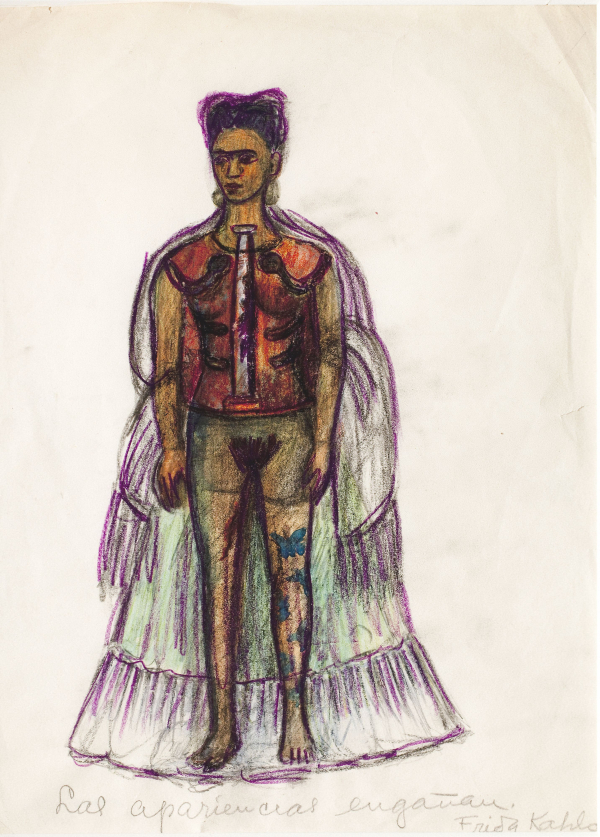de Young museum
March 21 - July 26, 2020

Nickolas Muray, "Frida with Olmeca Figurine, Coyoacán", 1939.
In 1930, Frida Kahlo first visited the United States, traveling to San Francisco with her husband, Diego Rivera. Ninety years later she returns to the de Young museum in the exhibition, Frida Kahlo: Appearances Can Be Deceiving. Offering an intimate perspective on the iconic artist and examining how politics, gender, trauma, sexuality, and national identity influenced Kahlo’s diverse modes of creativity, the exhibition showcases a trove of the artist’s personal items from the Frida Kahlo Museum in Mexico City, including photographs, clothing, jewelry and hand-painted orthopedic corsets, alongside about twenty of Kahlo’s paintings and drawings.


Today, Kahlo is known for her unique personal style as much as for her extraordinary art practice. A celebrity during her life, now elevated to icon status, her image is instantly recognizable and widely reproduced. Memorialized in arresting self-portraits and myriad photographs, her image is as much an expression of her creativity as her paintings are. Both her art and style reflect her deeply held personal beliefs, which led to the creation of a magnetic and enduring icon.

Kahlo had a special bond with San Francisco and the city greatly impacted her art. Her encounters with “Gringolandia” (as she called the United States) were formative and complex, and it was during these visits that Kahlo began to fashion her indigenous Mexican identity both in her self-portraits and in her iconic style. While in San Francisco, she painted a double portrait of herself and Rivera, which was the first time she depicted herself in what would become her iconic Tehuana-inspired dress, marking the beginning of her self-constructed persona.
“Kahlo used her appearance to express her Mexicanidad,
her identity as a Mexican woman at a time when her country was
undergoing great political and social change,” explains Hillary Olcott,
Associate Curator of the Arts of Africa, Oceania, and the Americas.
“This became especially important when she left Mexico, and traveled to
San Francisco for the first time. She created the double portrait here in the city, which is also where it was first shown outside of Mexico.”
The
exhibition also reveals how Kahlo used her dress and other creative
enterprises as outlets to cover but also to contend with the physical
and emotional traumas that shaped her life. Many of these personal items
came to light in 2004 after decades of being sealed off in her lifelong
home, La Casa Azul (now Museo Frida Kahlo) in Mexico City.This critically acclaimed exhibition originated at the Frida Kahlo Museum in Mexico City in 2012. The presentation at the de Young features paintings loaned from American museums and private collectors, highlighting relationships Kahlo established in San Francisco. It also complements the Fine Arts Museums’ costume collection as well as paintings and works on paper by Mexican artists Diego Rivera and José Clemente Orozco, in addition to the Fine Arts Museums’ collection of Mexican antiquities.
Frida Kahlo: Appearances Can Be Deceiving is organized by independent fashion curator Circe Henestrosa. Hillary Olcott, Associate Curator of the Arts of Africa, Oceania, and the Americas, serves as coordinating curator for the de Young’s presentation. The exhibition is on view at the de Young museum from March 21 through July 26, 2020.
About Frida Kahlo
The artist Frida Kahlo (Mexican, 1907–1954), is today an iconic figure, known as much for her intensely personal artwork as for her striking appearance. Kahlo began to paint while recovering from a nearly fatal bus accident in 1925, which left her unable to bear children. Kahlo famously married the Mexican muralist Diego Rivera (1886–1957) in 1929. Their union was unconventional—they in fact divorced briefly in 1939—but they were both deeply interested in their art and revolutionary politics. Many of Kahlo’s approximately 200 paintings deal with themes of gender, politics, and identity. Her paintings elude definition. Often associated with Surrealism, Kahlo herself resisted that categorization, stating that her paintings were “the frankest expression of [her]self.” Upon her death in 1954, Rivera and their close friend Dolores Olmedo requested that her personal artifacts be locked away in her childhood home, La Casa Azul, in Coyoacán, near Mexico City. Today, La Casa Azul houses the Frida Kahlo Museum—it was the museum staff who rediscovered the remarkable trove of personal artifacts that form the basis of this exhibition.